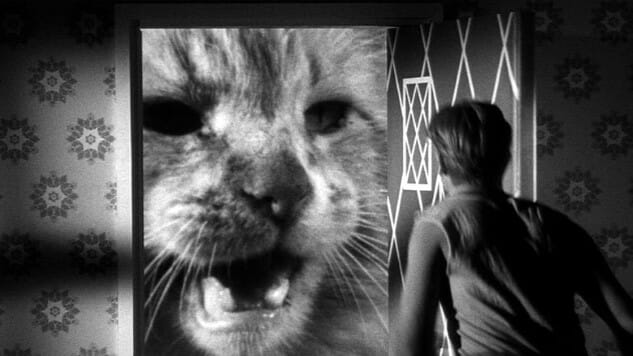The Best Horror Movie of 1957: The Incredible Shrinking Man

This post is part of Paste’s Century of Terror project, a countdown of the 100 best horror films of the last 100 years, culminating on Halloween. You can see the full list in the master document, which will collect each year’s individual film entry as it is posted.
The Year
We’ve entered the late 1950s, and the total volume of horror films being produced has gone into overdrive. The sci-fi/horror crossover is still going strong, with wave after wave of (rather cookie-cutter) giant monster movies such as The Deadly Mantis, The Amazing Colossal Man (more MST3K alums) and The Giant Claw, but this year also sees one of the pinnacles of the genre in the form of The Incredible Shrinking Man. Indeed, this era represents one of the peaks for science fiction as a populist film genre in general, coinciding as it did with the launch of the Sputnik satellite and the start of the space race.
At the same time, though, a noticeable evolution is making its presence felt in the horror genre: The rebirth of classical gothic horror, after a period of dormancy. You can see it in the film titles this year, which feature (around the globe) multiple vampire films, multiple “Frankenstein” films and I Was a Teenage Werewolf, to boot. Something is in the water, and the archetypes established via the Universal monsters are starting to come back into vogue.
Chief among the revivalists is a company whose name will appear steadily in these entries for the next decade, and then some: Britain’s Hammer Film Productions. Beginning with this year’s Curse of Frankenstein, the company would launch a gloriously colorized series of classical, gothic monster movies, reawakening old terrors associated with characters such as Frankenstein’s Monster, Dracula, mummies and werewolves, now presented in the lurid new tones of Eastmancolor, where pulses of bright arterial blood became the gruesome new standard. Benefitting from atmospheric set pieces and stylish direction by the likes of Terence Fisher, the newly christened concept of “Hammer Horror” would launch a new wave of imitators throughout Europe (especially Italy) and the U.S.A., proving that the horror genre didn’t necessarily need to lean on science fiction in order to be successful.
It was The Curse of Frankenstein that led the way, a film that was very difficult to keep out of the top spot for 1957—but fear not, as Hammer will be well represented in subsequent years. Starring the duo of Peter Cushing and Christopher Lee, who would become the two faces most associated with Hammer Horror productions, the film reevaluates the legacy of Universal’s Frankenstein films by cleverly shifting its focus away from the monster and onto the doctor himself. Whereas the Universal Dr. Frankenstein portrayed by Colin Clive, or his sons portrayed by Basil Rathbone and Cedric Hardwicke are all characterized as well-intentioned scientists who get swept up in the heady thrill of discovery and don’t realize their faults until it’s too late, Cushing’s Frankenstein is an imperious cad, through and through. A brilliant but egotistical rake, this Frankenstein doesn’t hesitate to resort to dirty tactics or outright murder to get what he wants, believing that the importance of his prospective discoveries will mean that the ends will justify whatever means he chooses to employ. In order to bring his creation to life, he’ll put friends and family into danger time and time again, making it clear that although Lee’s monster is hideous to behold, it’s clearly Dr. Frankenstein who is the film’s villain—traits that would be inherited by other film characters such as Re-Animator’s Herbert West, some 30 years later. The film would go on to inspire a bevy of sequels, in which Dr. Frankenstein gradually becomes something of an anti-hero, descending ever deeper into his desperation to perfect his scientific breakthrough.
1957 Honorable Mentions: The Curse of Frankenstein, Night of the Demon, Quatermass 2, 20 Million Miles to Earth, The Deadly Mantis, Lust of the Vampire, The Amazing Colossal Man
-

-

-

-

-

-

-

-

-

-

-

-

-

-

-

-

-

-

-

-

-

-

-

-

-

-

-

-

-

-

-

-

-

-

-

-

-

-

-

-








































